
- Home
- Travel Packages
- Top Destination
-
Travel Attraction
By Category
Top Attraction

- Travel Agents
- Car Rentals
- Hotels
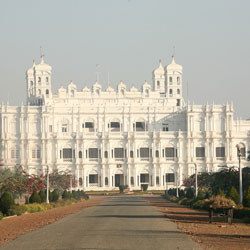
About The Jai Vilas Palace The Jai Vilas Palace is a grand and majestic palace located in Gwalior, Madhya Pradesh, India. Built in 1874 by Maharaja Jayaji Rao Scindia of Gwalior, this palace is known for its blend of European and Indian architectural styles. The palace is spread across an area of 12,40,771 square feet and is one of the largest palaces in India. Timings Of Jai Vilas Palace The Jai Vilas Palace is open to visitors from 10:00 AM to 4:30 PM on all days of the week except Mondays and public holidays. Entry Fee The entry fee for Jai Vilas Palace is Rs. 100 for Indian nationals and Rs. 600 for foreign nationals. There is an additional fee for photography and videography inside the palace. Required Time And Restricted Items It takes around 2-3 hours to explore the Jai Vilas Palace thoroughly. Visitors are not allowed to carry any food items, cameras, or electronic devices inside the palace. Architecture Of Jai Vilas Palace The Jai Vilas Palace is a stunning example of European architecture with a touch of Indian design elements. The palace features intricately designed interiors, marble flooring, ornate chandeliers, and a beautiful Durbar Hall that can accommodate up to 500 guests. The palace also houses a silver train, which is one of the major attractions. Best Time To Visit The best time to visit Jai Vilas Palace is during the winter months from October to March when the weather is pleasant and ideal for exploring the palace. How To Reach The Jai Vilas Palace is located in the heart of Gwalior city and is easily accessible by road. The nearest railway station is Gwalior Junction, which is well-connected to major cities in India. The nearest airport is Gwalior Airport, which is around 15 km away from the palace. History Of Jai Vilas Palace The Jai Vilas Palace was commissioned by Maharaja Jayaji Rao Scindia in 1874 and was designed by Sir Michael Filose, a British architect. The palace served as the residence of the Scindia royal family and has now been converted into a museum showcasing the rich heritage and culture of Gwalior. Inside Jai Vilas Palace Inside the Jai Vilas Palace, visitors can explore the various rooms and galleries that display the royal artifacts, paintings, furniture, and weapons of the Scindia dynasty. The Durbar Hall is the highlight of the palace with its opulent decor and grandeur. Traveling Tips It is advisable to wear comfortable footwear as the palace grounds are expansive and require a fair amount of walking. Visitors are also recommended to hire a guide to get detailed insights into the history and significance of the palace. Hotels Near Jai Vilas Palace There are several hotels near Jai Vilas Palace where visitors can stay during their trip. Some of the popular hotels include: 1. Taj Usha Kiran Palace 2. Hotel Grace 3. Hotel Adityaz 4. Hotel Gwalior Regency 5. The Central Park Hotel Nearby Tourist Spots Of Jai Vilas Palace There are several tourist spots near Jai Vilas Palace that visitors can explore: 1. Gwalior Fort 2. Sun Temple 3. Sas Bahu Temple 4. Tansen's Tomb 5. Gujari Mahal Archaeological Museum
Explore More
Situated in Bhopal, The Indian Bharat Bhawan is a multi-arts museum and complex. The place was developed by the Government of Madhya Pradesh and opened for the public in the year 1982. The institution is run by an autonomous Trust of 12 members. The location of The Indian Bharat Bhawan is mesmerizing, as it faces the Upper Lake in Bhopal. The structure is a hub that houses fine art workshops, an art gallery, a studio theatre, an open-air amphitheater, a museum for tribal and folk art, an auditorium and libraries of folk music/ classical music/ Indian poetry. The Indian Bharat Bhawan was inaugurated by then Prime Minister, Indira Gandhi. Since the place opened, it has become an important cultural institution of India. It is believed to the best cultural place that attracts a lot of scholars, artists and students from Mumbai, Indore, Kolkata and various place of the world.
Explore More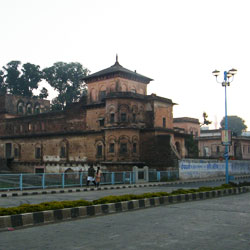
About The Gohar Mahal The Gohar Mahal, located in Bhopal, India, is a beautiful historical palace that showcases the rich cultural heritage of the region. Built in the 19th century by Gohar Begum, the first female ruler of Bhopal, the palace is a fine example of Mughal and Hindu architecture. Timings Of Gohar Mahal The Gohar Mahal is open to visitors from 10:00 AM to 5:00 PM, seven days a week. Entry Fee The entry fee for Gohar Mahal is INR 20 for Indian nationals and INR 250 for foreign tourists. Required Time And Restricted Items Visitors typically spend around 1-2 hours exploring the Gohar Mahal. However, photography is not allowed inside the palace, and visitors are required to deposit their cameras and phones at the entrance. Architecture Of Gohar Mahal Gohar Mahal's architecture reflects a blend of Mughal and Hindu styles, featuring intricate carvings, delicate jharokhas (balconies), and beautiful arches. The palace's striking facade and grandeur make it a must-visit for architecture enthusiasts. Best Time To Visit The best time to visit Gohar Mahal is during the winter months (October to March) when the weather is pleasant, making it ideal for exploring the palace and its surroundings. How To Reach Gohar Mahal is easily accessible by road, located in the heart of Bhopal city. Visitors can take a taxi, auto-rickshaw, or public transport to reach the palace. History Of Gohar Mahal The Gohar Mahal was constructed in the 19th century by Gohar Begum, a powerful female ruler of Bhopal. The palace served as a royal residence and later became a cultural hub for artists, musicians, and poets during the Nawabi era. Inside Gohar Mahal Inside Gohar Mahal, visitors can explore the intricately designed chambers, courtyards, and halls that once hosted grand events and festivities. The palace also houses a museum showcasing artifacts and relics from the bygone era. Traveling Tips It is advisable to wear comfortable footwear as exploring the palace involves walking through narrow corridors and staircases. Additionally, carrying a bottle of water and sunscreen is recommended, especially during the summer months. Hotels Near Gohar Mahal With Names Some of the hotels near Gohar Mahal include Hotel Sarthak, Jehan Numa Palace Hotel, and Hotel Shubh Inn. These hotels offer comfortable accommodations and are situated near the palace. Nearby Tourist Spots Of Gohar Mahal There are several other attractions near Gohar Mahal that visitors can explore, such as the Upper Lake, Bhojpur Temple, and Taj-ul-Masajid. These sites offer a glimpse into the rich history and culture of Bhopal.
Explore More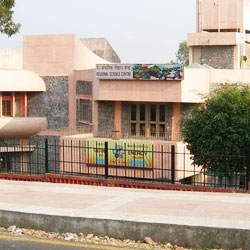
The Regional Science Centre is situated in the Shyamla Hills area of Bhopal, India. The place is constructed with the mission to popularize science and technology among people and specially among students. The place was inaugurated in the year 1995 by the then president Mr. Shankar Dayal Sharma. The place is a popular destination and one of the constituent units of the National Council of Science Museums or NCSM. The Regional Science Centre is open every day of the week. However, it is closed on festivals of Holi and Diwali. The centre incorporates over 266 science exhibits out of which most are interactive. The campus of The Regional Science Centre spans over 5-acre out of which 3-acres are dedicated to the Science Park that consists of more than 60 exhibits. Besides the park, the centre has a zoo and a small Dinosaur Park.
Explore More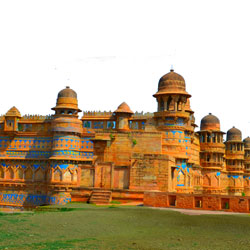
About The Gwalior Fort The Gwalior Fort, located in the city of Gwalior in the state of Madhya Pradesh, India, is one of the most impressive forts in the country. The fort stands on an isolated rock outcrop overlooking the city and is considered an architectural marvel. It has been ruled by various dynasties over the centuries and has witnessed many historical events. Timings Of Gwalior Fort The Gwalior Fort is open to visitors from 8:00 am to 6:00 pm every day of the week. It is advisable to visit the fort during the daytime to enjoy the panoramic views of the city and surrounding areas. Entry Fee The entry fee for the Gwalior Fort is INR 75 for Indian nationals and INR 250 for foreign tourists. There is an additional charge for carrying a camera inside the fort premises. Required Time And Restricted Items It is recommended to spend at least 2-3 hours exploring the Gwalior Fort to fully appreciate its beauty and historical significance. Visitors are not allowed to carry any food items or alcoholic beverages inside the fort. Architecture Of Gwalior Fort The architecture of the Gwalior Fort is a blend of Hindu and Muslim styles, reflecting the rich cultural heritage of the region. The fort complex includes several palaces, temples, water tanks, and reservoirs, all built with stunning craftsmanship. Best Time To Visit The best time to visit the Gwalior Fort is during the winter months of October to March when the weather is pleasant and ideal for exploring the fort and its surroundings. Avoid visiting during the summer months as the temperatures can be quite high. How To Reach The Gwalior Fort is easily accessible by road, rail, and air. The nearest airport is Gwalior Airport, which is well-connected to major cities in India. The Gwalior Railway Station is also well-connected to various parts of the country. Visitors can hire a taxi or auto-rickshaw to reach the fort from the city center. History Of Gwalior Fort The Gwalior Fort has a rich history dating back to the 8th century when it was founded by the Tomar dynasty. It has been ruled by various dynasties such as the Mughals, Marathas, and British, each leaving their mark on the fort's architecture and structure. Inside Gwalior Fort Inside the Gwalior Fort, visitors can explore various attractions such as the Man Singh Palace, Gujari Mahal, Teli-ka-Mandir, Sas-Bahu Temples, and the Scindia School. Each of these structures has unique architectural features and historical significance. Traveling Tips It is advisable to wear comfortable clothing and footwear while visiting the Gwalior Fort as there is a fair amount of walking involved. Carry a bottle of water and sunscreen to stay hydrated and protected from the sun. Hire a local guide to learn more about the fort's history and significance. Hotels Near Gwalior Fort There are several hotels near the Gwalior Fort that offer comfortable accommodation options for visitors. Some of the popular hotels in the vicinity include Taj Usha Kiran Palace, Neemrana's Deo Bagh, and Hotel Grace. Nearby Tourist Spots Of Gwalior Fort After visiting the Gwalior Fort, travelers can explore other nearby tourist spots such as the Jai Vilas Palace, Tomb of Tansen, Gwalior Zoo, and Sarod Ghar. These attractions offer a glimpse into the rich cultural heritage of Gwalior and are worth a visit.
Explore More
Dedicated to the memory of the great Queen Durgavati, it is her memorial and museum, which houses a fine collection of sculptures, inscriptions and prehistoric relics. The museum has a good collection of artifacts and also has a section dedicated to artifacts and photos related to Mahatma Gandhi.
Explore More
A pillar of Hindustani classical music, the great Tansen, the musician extraordinaire of Akbar's Court, lies buried in Gwalior. The beautiful garden, in which the tomb is located, is the venue of the annual music festival held during November-December. Distinct personalities from abroad also visit and rejoice music. Gwalior is also renowned for the tomb of Tansen, the musician extraordinaire of Akbar's Court (one of his 'nau ratan', nine jewels). Gwalior retains a strong musical tradition, and continues to be an influential force in Hindustani classical music. Tansen, an exponent of the Dhrupad style, went on to evolve the Gwalior Gharana style, whose contemporary exponent is the globally renowned Sarod player, Amjad Ali Khan. The memorial to this great musician has a pristine simplicity about it, built in the early Moghul architectural style. More than a monument, the tomb is part of Gwalior's living cultural heritage. Leading musicians of the country gather here to give performances during the festival.
Explore More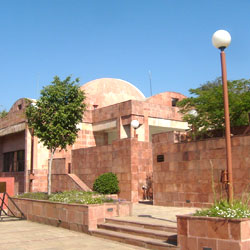
Indira Gandhi Rashtriya Manav Sangrahalaya (A Post Colonial)
The Indira Gandhi Rashtriya Manav Sangrahalaya (National Museum of Mankind) is a unique Museum, on the Shamla Hills on the Upper Lake front. It is a postcolonial museum of communities rather than objects. A road leading to Van Vihar branches off uphill to Manav Sangrahalaya - an anthropological institution housing a vast repertoire of tribal and folk arts from across India. Situated on the hill by the side of the Upper Lake, surprisingly an entire fishing village has been replicated towards the lakeside with a black, sleek snake boat from Kerala catching immediate attention. Even its shelter has been designed in an ethnic fashion. Most of it is now covered in wild grass medicinal plants used by the tribals in traditional system of medicine. It is a unique museum spread over 200 acres of undulating land, situated in a prehistoric site and may be the only museum in the world strewn with numerous prehistoric painted rock shelters. It is engaged in recollection rather than collection. This has been curated directly by the folk and tribal communities, camping at site, to create a miniature presentation of Indian folk ways through display of ecospecific habitations and subsistence practices in the tribal, coastal, desert, and Himalayan habitats. The tribals themselves built a hilltop village resembling a tribal hamlet with each shack unique to a tribe from one part of the country or the other with original material. This part of the museum has been put together painstakingly over the years by inviting one tribe at a time. The library, audio-visual archive, computerized documentation and the collection of ethnographic specimens in the Museum, though modest in size are among the best in the world.
Explore More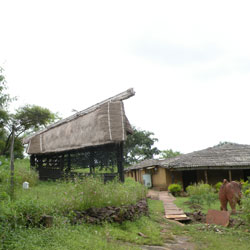
Tribal Habitat (Museum of Man):
The Tribal Habitat, an open-air exhibition on Shamla Hills provides a picture of the tribal cultures of India. It is a presentation of actual-size dwellings typical of contemporary tribal cultures in various states of India.
Explore More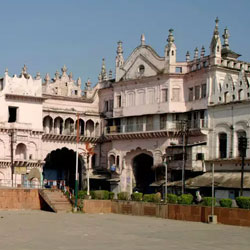
Shaukat Mahal And Sadar Manzil
The Shaukat Mahal and Sadar Manzil show a blend of Asian and Western styles of architecture which creates this building stand out in the crowd of the traditional Islamic architecture of Bhopal. Shaukat Mahal Travel Tips Recommended time of arrival: 8.00 am – 6.00 pm Shaukat Mahal Timings The place is open during the office hours of the Municipal Corporation. It is advised to check the history and customer’s reviews on the website of a travel operator. Timings for Entry It is advised to take a trip of the two during the morning hours or in the evening to enjoy the atmosphere of the place. Shaukat Mahal and Sadar Manzil can be visited through the timings of 7:00 AM - 7:00 PM in April to September, and from 7:00 AM to 6:00 PM from October to March. The buildings rest closed for visitors on Fridays. There are no pass or entry fees for both Shaukat Mahal and Sadar Manzil. Festival of Bhopal Looking Festival: It is held in January for around 4 days annually, the festival promotes folk dances to merge geopolitical boundaries and limits. History of Shaukat Mahal and Sadar Manzil The history of Shaukat Mahal and Sadar Manzil tells that it was designed by a corrupt Frenchman who is known to be from the Bourbon Dynasty of France. The Shaukat Mahal and Sadar Manzil imitate an exclusive blend of oriental and occidental architectural styles. Description of Shaukat Mahal and Sadar Manzil Gothic and post resurgence styles have been efficiently used in the construction of the Shaukat Mahal, which ultimately gives it an enchanting effect. Many convolutedly carved arches on the roof of the Shaukat Mahal beside with the alabaster white structure of the building give it a distinctive look. The outside of the palace is decorated with beautiful and exotic floral designs giving the Shaukat Mahal an eco-friendly appearance. The Sadar Manzil that was the Hall of Public Audience through the rule of the princes borders the Shaukat mahal. This building is a brick red structure of flamboyant appearance. The Shaukat Mahal and Sadar Manzil are bounded by beautiful lawns that give it a picture postcard effect. How to reach Shaukat Mahal and Sadar Manzil? The Shaukat Mahal and Sadar Manzil are situated at the entry of the Chowk area, in the centre of the city. It is simply reached by all modes of transport inside the city. The Mahal is amazingly attached by road. You can reach this place easily by bus at Moti Masjid Bus Stop and by Minibus, Rickshaw, Taxi, hiring a Cab. Best time to visit The best time to visit Bhopal is during the winter months of October to March. The weather is an ideal one for exploring and experiencing the rich flavours of the grand city. July-September is the second-best time to visit the city. Tourists spots nearby Shaukat Mahal • MP tourism boat club- It is an astonishing place for nature lovers, journey seekers, and experience seekers. When it comes to boating in the lake, this place is present an unforgettable boating experience. • Tattenham club- It is one of its kind pub in Bhopal. Based on the theme of horse racing it is a perfect place to relax with friends. • Newmarket- Experience some traditional shopping here. • Azad market- a recommended for having sumptuous food in Bhopal. Experience some native taste of Bhopal here. • Bhopal on the wheel- is a government initiative that offers a guided tour of the whole city in just a few hours. The tourists are engaged with the toy-train look-alike open bus. The initial point of the tour is Palash Residency. From there the bus goes via hills and the old city. • Regional museum of natural history- It is a small and beautiful museum of Natural History. It takes you to close to nature via many beautiful and informative models. It is bounded by the lush green garden. • Van Vihar National Park- this is a sprawling wildlife sanctuary in Bhopal. Snugged between Shamla Hills and Upper Lake, it is one of the most visiting places in Bhopal for nature lovers and bird watchers. The place is a home of many creatures like the leopard, sambar, nilgai, turtle, star tortoise, crocodile, langur, porcupine, wild boar, and chital.
Explore More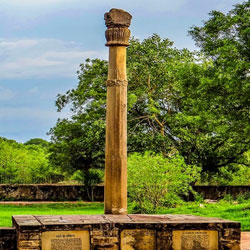
The Heliodorous Pillar, Vidisha was erected in central India, on the outskirts of Vidisha in 113B.C. The pillar is considered being one of the very important and significant archaeological finds on the subcontinent of India. The name of the pillar was given after Heliodorous, the ambassador of an Indo-Greek king from Taxila, named Antialcidas. On the pillar, he inscribed his dedication in Brahmi script, which declared him a Vasudeva devotee, or a devotee of the supreme deity. The pillar is said to be symbolic of the 'cosmic axis' and express the deity's cosmic totality it joins the earth's space and heaven. The Heliodorous pillar, Vidisha is located near two rivers. It is about 37 kilometers northeast from Bhopal, then 11 kilometers from Buddhist Sanchi stupa and then 4 kilometers from Udayagiri site. Alexander Cunningham discovered the Pillar in 1877. There were two major archaeological excavations done in the 20th century which revealed that the pillar was a part of the very ancient temple of Vasudeva. There are inscriptions and temples found which are known to be the earliest evidence of Vasudeva and Krishna's devotion. Also, it tells a lot about the early Vaishnavism existing in India. The inscriptions found on the Heliodorous pillar say that Vasudeva Krishna was called Deva which means the supreme deity, “God of Gods”. The Heliodorous pillar, Vidisha is the erection that shows the manifestation of Bhagavata, the worship of Vrishni heroes a type of ancient cult, and simultaneously there was also Buddhism flourishing in Sanchi. History: There was an excavation in the year 1913 which said that there was a significant part of the Heliodorous pillar, Vidisha which lies below the platform. It sits on top of even much more old and ancient pillar which probably got damaged by floods. Over time, there was silt from different floods that got deposited and the platform got raised at a point. The pillar shaft has base support made of the two placement stones which are held with the layer of a stone metal. Above it was the untrimmed stone part of the pillar. And above the section which is untrimmed lies an octagonal trimmed cross-section. The real ground level was around 4.5 centimeters above the trimmed and untrimmed section. Then above the length with the octagonal facet lies that section of the pillar which has sixteen facets. The section of thirty-two facets lies above the sixteenth section. Beyond this part is the round short pillar section, which goes all the way up to where previously was the crowning emblem, which is now missing. The pillar is around 17.7 feet above the square platform. The platform itself is above the ground for around 3 feet. The presently visible part of the octagonal portion of the pillar is around 4feet and 10inches high. The sixteenth section is completely visible and also is 6 feet and 2inches high. Also, the thirty twos are completely visible and it's around 11.5 inches high. While the round portion is around 2-feet 2-inches high. Inscriptions On the Heliodorous pillar, Vidisha is two inscriptions. The authors who have analyzed the inscriptions are Sukthankar, E.J.Rapson, Shane Wallace and Richard Salomon. The texts used in the inscriptions are written in Brahmi script the language which is used is Praktrit along with some Sanskritised spellings. The two inscriptions found on the pillar's octagonal base each spanning three sides along with the remaining two of the sides blank. • The very first inscriptions tell about the religious decoration of Heliodorous. The identity and name of the King Bhagabhadra are contested in the longer inscription. Some early scholars proposed that he might have been the very 5th ruler of the Dynasty of Sunga, as it has been described in some of the Puranic lists. • The second inscription did not have anything else but they’ve written about the lines from Mahabharata. • But, later in some excavation, done by German archaeologists near Sonkh, Mathura had shown, the end of the Sunga Dynasty happened even before the installation of Heliodorous pillar, Vidisha. Therefore, it can probably be true, that Bhagabhadra might have been some local ruler. Various other scholars have very differently translated the virtues in shorter inscriptions. Culture of Vidisha-Heliodorous pillar In the Heliodorous pillar, vidisha cultures there are mridang and matki music. Native festivals and functions are also enjoyed along with dance and music. While usually, different people are wearing different clothes depending on their changing cultures and religions. But the majority of all men almost wore the very traditional dhoti and mirza along with a turban. And for the women, there are legends and then choli and also there is chunni which does the work of covering up the head. There are also, very beautiful traditional handicrafts which include some kinds of cane works mad bamboo, ornament and metal crafts and folk paintings. Also, apart from just agriculture, there is tattooing done by people as another source of livelihood. Things to do: There many points of interests to visit when you are around Vidisha, in Madhya Pradesh. • The District Museum- In Vidisha, there is an amazing museum that is situated in the city’s heart. There are many beautiful terracottas, sculpted sculptures and even coins that date to the 10th century. There is also, Harappan art showcased in the museum. The very famous Yaksha statue is the specialty of this museum. The statue is almost of the old Sunga or Mauryan Empire. • Different Temples- Many temples can be found in the town. The temples are grand and have beautiful houses. The very intricate and gorgeous carvings which are done in the temple will leave you all awestruck. Many old temples get many visitors, everyone. All walk-in to offer prayers to God seek blessings of the almighty. Lastly, the Heliodorous pillar, Vidisha is a must-visit for sure. Going to Vidisha for a vacation is a great idea. People can go there and enjoy its grandeur and glory. It's enough for one to feel relaxed and also to slightly see what the medieval era looked like. The place is very well connected with both railways and roadways. Also, it is just 1.5 hours from the airport of Bhopal, therefore, it is accessible. The climate doesn't play much of a crucial role therefore one can visit Vidisha whatever they feel like. But most people go and take a visit to the Heliodorous pillar, Vidisha for being known for the ancient old architectures and religious items.
Explore More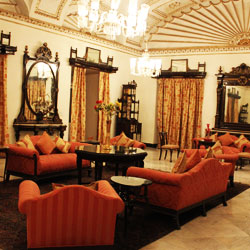
The Scindia Museum situated in the Jai Vilas Palace, has a collection ranging from sculptures, bronzes, miniature paintings, manuscripts and coins. The Gujari Mahal Archaeological Museum houses rare antiquities. The old ancestral house of the legendary Ustad Hafiz Ali Khan has been converted into 'Sarod Ghar' - Museum of Music by the Ustad Hafiz Ali Khan Memorial Trust. The Municipal Corporation Museum has a very fine natural history section. Museums and art galleries are treasure houses and the beautifully maintained palaces give Gwalior its inimitable regal flavour. If Man Mandir reflects Man Singh�s aesthetic sensibilities, Gujari Mahal speaks of his love. The courage and beauty of Mrignayani and her love with Raja Mansingh are now a part of popular folk tradition. Within the fort are some marvels of medieval architecture.
Explore More5D - 4N Madhya Pradesh Tour Package
5 Days/ 4 Night
Bhopal - Indore - Ujjain - Sanchi
Ujjain - Mahakaaleshwar - Omkareshwar Jyotirlinga Tour Package
3 Days/ 2 Night
Indore
Madhya Pradesh Tour Package 5D - 4N
5 Days/ 4 Night
Bhopal - Indore - Ujjain - Sanchi
Mystic Khajuraho Getaway from Lucknow
3 Days/ 2 Night
Khajuraho
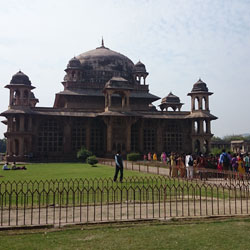
If you are in this fabulous city of Madhya Pradesh, you must have a plan visiting the Gwalior Fort. For your information, the tomb is only 1 km away from the fort. Apart from Mohammed Ghaus, Tansen is also buried here. Besides its historical importance, the tomb is also famous for its great architecture. You will get a memorable visit here as it is counted among the most protruding sightseeing attractions of Gwalior, Madhya Pradesh. Visitor Information: The tomb of Mohammed Ghaus, Gwalior is one of the protuberant pilgrimages for both Hindu and Muslim religious people. History: The construction of the tomb of Mohammed Ghaus was done in 16th century AD when Mughal Samrat Babar was the ruler here. Afghan Prince Ghaus Mohammed later turned into a Sufi saint. According to the legend, in 1526 CE, he assisted Babar to conquer the Gwalior Fort. Apart from this, the Sufi saint has many other influences over the Mughal emperors – Babar and his son Humayun. Architecture: As Mohammed Ghaus was alive during the Mughal reign, his tomb structure contains typical Mughal architecture. It is standing on the hexagonal pillars at all of its four corners. The building of the entire tomb is square-shaped. There is another square-shaped dome on top of it that is adorned with ceramic tiles of blue color. There are kiosks too inside the dome which are also hexagonal-shaped and their corners are together slopped eaves which are projected from the exterior. The exterior and interior of the tomb walls include latticework and sophisticated carvings. Festival: The tomb of Tansen is situated surrounded by green gardens and carries the signature style of the Mughal architecture. It serves as one of the existing cultural heritage of the city. Every year during the month of November- December, Tansen Music Festival is organized here which s a national level program and thus various great musicians from every part of the nation come to attend the festival. A nice and serene atmosphere is created with their influential music performances. Best Time to Visit: The best time to visit the Tomb of Mohammed Ghaus and Tansen is during November- February. This time, the weather remains pleasant here. You can visit the tombs between 9 AM and 5 PM every day. How to Reach? • By air – You need to board a flight for Rajmata Vijaya Raje Scindia Airport, Gwalior. It is 13 km away from the destination. • By train – Simply board a train to reach Gwalior Junction. It is well connected with railways to many parts of the country. • By bus – Nearest bus station is Gwalior bus station. Avail any private or public bus services to reach here from any parts of India. Nearby Attractions: The Tomb of Tansen or the memorial of Tansen is situated pretty close to the tomb of Mohammed Ghaus, Gwalior. Tansen was one of the nine jewels’ in the court of Akbar who was a popular musician of that era. In fact, he is known as one of the most influential personalities in the tradition of North India and also in Hindustani classical music. He is best remembered and respected in the world of classical music for his epic compositions of Dhrupad which has created a range of new sagas. He also wrote two larger-than-life books on music including Sangita Sara and Sri Ganesh Stotra. Mohammed Ghaus was his guru and thus he also got buried close to his tomb. Undoubtedly, these burial sites are a great piece of architecture. Plan your trip now!
Explore More
Chhatris or cenotaphs erected in memory of the Holkar rulers and their families are incomparable examples of Maratha architecture and sculpture. These Chhatris were the temples where Holkars used to attend Poojas. The largest and the most impressive is that of Malhar Rao Holkar I lavishly decorated with frescoes while that of Rani Ahilyabai is also important. As time passed, they were neglected and shopkeepers and hawkers encroached the land around them. But recently, District Administration forcefully got them moved from the place and secured back the significance and beauty. Thus they got back historic significance and glory. On the banks of River Khan, it has seven memorials of the Holkar kings but the inner sanctums are locked.
Explore More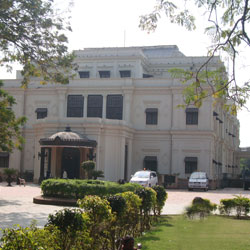
About The Lal Baug Palace The Lal Baug Palace is a stunning architectural marvel located in Indore, Madhya Pradesh. Also known as the "Lal Baag Ka Kila," this palace was built by the Holkar dynasty, who ruled the region. The palace is a perfect blend of European and Indian architectural styles, making it a unique attraction for history buffs, architecture enthusiasts, and tourists alike. Timings Of Lal Baug Palace The Lal Baug Palace is open to visitors from 10:00 AM to 5:00 PM on all days of the week except Mondays. Entry Fee The entry fee for Lal Baug Palace is INR 10 for Indian nationals and INR 250 for foreign tourists. Required Time And Restricted Items It takes around 1-2 hours to explore the entire Lal Baug Palace. Visitors are not allowed to carry outside food, pets, or any sharp objects inside the palace premises. Architecture Of Lal Baug Palace The Lal Baug Palace showcases a unique blend of Gothic, Renaissance, and Palladian architectural styles. The palace features intricate carvings, beautiful gardens, grand courtyards, and opulent interiors, reflecting the grandeur of the Holkar dynasty. Best Time To Visit The best time to visit Lal Baug Palace is during the winter months from October to March when the weather is pleasant, making it ideal for exploring the palace and its surroundings. How To Reach The Lal Baug Palace is located in the heart of Indore city, making it easily accessible by road. Visitors can hire a cab, auto-rickshaw, or public transportation to reach the palace. History Of Lal Baug Palace The Lal Baug Palace was built in the early 20th century by the Holkar dynasty rulers as their residence. The palace served as the seat of the Holkar dynasty until India gained independence in 1947. Today, it stands as a symbol of the rich cultural heritage of Madhya Pradesh. Inside Lal Baug Palace Inside the Lal Baug Palace, visitors can explore the grand Durbar Hall, the royal bedrooms, the royal kitchen, the ballroom, and the royal stables. The palace also houses a museum showcasing artifacts, paintings, and sculptures from the Holkar era. Traveling Tips It is advisable to wear comfortable footwear while exploring the palace as there is a lot of walking involved. Visitors are encouraged to hire a guide to learn about the history and significance of different sections of the palace. Hotels Near Lal Baug Palace With Names Some of the hotels near Lal Baug Palace include Hotel Infiniti, Sayaji Hotel, Radisson Blu Hotel, and Lemon Tree Hotel. These hotels offer comfortable accommodations and easy access to the palace. Nearby Tourist Spots Of Lal Baug Palace Some of the nearby tourist spots of Lal Baug Palace include Rajwada Palace, Kanch Mandir, Annapurna Temple, Central Museum, and Patalpani Waterfall. Visitors can explore these attractions to get a glimpse of the rich history and culture of Indore.
Explore More
Located in a quaint corner and away from the noises of the city, Krishnapura Chhatri is a popular and must-see tourist attraction. Erected in the traditional Maratha style of architecture, these chhatris are the cenotaphs of the royal Holkar family. The Holkar dynasty was the ruling dynasty in Indore that reigned for a prolonged period of time. To commemorate the rulers, these chhatris were constructed in their honor.Why Are Chhatris Popular?Each chhatri is a cenotaph that is dedicated to the Holkar kings that served the throne throughout their life. Their selfless dedication left a great impact on the hearts and minds of people that led to the construction of Krishnapura Chhatri.The second reason for them being a popular attraction is the jaw-dropping Maratha style of architecture and location near the River Khan. Such location of the tantalizing cenotaphs makes the site a must-see spot for all. It has a soul-soothing ambiance that refreshes the senses immediately.Best Time To Visit:-Krishnapura Chhatris in Indore are huge crowd pullers. Throughout the year, they attract visitors extensively and thus, it is a place that can be visited on a daily basis without hassle.The entry to Krishnapura Chhatri is free for all but littering the premises leads to a heavy penalty.Reaching There:-These enticing architectural marvels have a well-established network of roadways and railways that connect them with the rest of Indore. By hiring the service of the local transit, an individual can reach Krishnapura Chhatri conveniently.Nearest Railway Station:- Indore JunctionNearest Airport:- Rani Ahilya Bai Airport
Explore More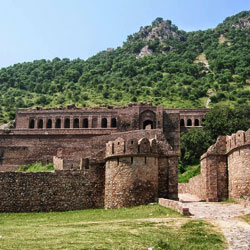
About The Bandhavgarh Fort Bandhavgarh Fort stands tall on a hilltop, offering panoramic views of the surrounding landscape. The fort is believed to date back to the 10th century and has witnessed numerous rulers and dynasties over the centuries. It is a perfect blend of history, architecture, and natural beauty. Timings of Bandhavgarh Fort The Bandhavgarh Fort is open for visitors from sunrise to sunset every day. It is recommended to visit the fort early in the morning or late in the evening to avoid the scorching heat of the day and to enjoy the beautiful views during sunrise or sunset. Entry Fee The entry fee for visiting Bandhavgarh Fort is INR 500 for Indian nationals and INR 1,000 for foreign tourists. There might be additional charges for carrying cameras or video equipment inside the fort premises. Required Time and Restricted Items It takes approximately 2-3 hours to explore the entire Bandhavgarh Fort, including the various structures, temples, and viewpoints. Visitors are not allowed to carry plastic bottles, alcohol, or non-vegetarian food inside the fort premises. Architecture of Bandhavgarh Fort The architecture of Bandhavgarh Fort is a fine example of ancient Indian craftsmanship. The fort is adorned with intricate carvings, beautiful sculptures, and stunning frescoes that reflect the grandeur of its past. The fort complex also includes temples, reservoirs, and ruins of old structures that add to its charm. Best Time to Visit The best time to visit Bandhavgarh Fort is during the winter months from October to March when the weather is pleasant and conducive for sightseeing. The monsoon season from July to September also offers lush greenery and a refreshing atmosphere, making it another good time to visit. How to Reach Bandhavgarh Fort is located in Jabalpur, Madhya Pradesh, and can be easily reached by road from major cities like Jabalpur and Umaria. The nearest airport is at Jabalpur, approximately 190 km away, and the nearest railway station is at Umaria, around 35 km away. Visitors can hire a taxi or take a bus to reach the fort from these points. History of Bandhavgarh Fort Bandhavgarh Fort has a rich history that dates back to ancient times. It was ruled by various dynasties like the Chandela rulers, the Mughals, and the Marathas before coming under British control. The fort played a significant role in the history of Central India and was a strategic stronghold for many rulers. Inside Bandhavgarh Fort Inside Bandhavgarh Fort, visitors can explore various structures like the Rani Ki Baori (Queen's Stepwell), the Baghel Museum, and the three main gates - the Ganesh Pol, the Lakshman Pol, and the Karan Pol. The fort also houses several temples dedicated to Hindu deities like Vishnu and Shiva, adding a spiritual touch to the historical site. Traveling Tips - Carry water bottles, sunscreen, and comfortable footwear while visiting Bandhavgarh Fort. - Respect the rules and regulations of the fort premises and maintain the cleanliness of the surroundings. - Engage with local guides to learn more about the history and legends associated with the fort. Hotels Near Bandhavgarh Fort Several accommodation options near Bandhavgarh Fort cater to different budgets and preferences. Some of the popular hotels in the vicinity include: - Bandhavgarh Jungle Lodge - Mahua Kothi - Bandhav Vilas Nearby Tourist Spots of Bandhavgarh Fort While visiting Bandhavgarh Fort, tourists can explore other nearby attractions like the Bandhavgarh National Park, known for its rich biodiversity and tiger population. Other notable places include the Badi Gufa (Big Cave), the Shesh Shaiya (Sculpture), and the Three Cave Point, each offering a unique experience for visitors.
Explore More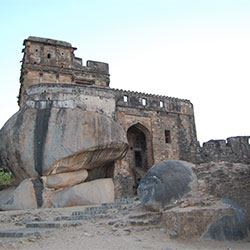
Constructed during the era of the Gond Dynasty, Madan Mahal is a famous fort in Jabalpur. It was built in the 11th century as a watchtower. It has a close association with Rani Durgavati and her son Madan Mohan, after whom the palace is named. This fort, though not an architectural marvel in terms of its architecture, but is a magnificent example of the ancient monuments that were built in the ancient times.Why Is It Famous? Madan Mahal is famous because of its location atop the hill. According to its strategic location, the entire town of Garha, where the fort is located, can be viewed. In the bygone times, the royal army used to keep an eye on the entire town of Garha, including its outskirts to make sure that the kingdom is safe from the enemies. It also had some military posts and horse stables that clearly indicated of this fort being a watchtower. Even today, the remnants of the cannons can be seen in this fort.Best Time To Visit:-Madan Mahal is a huge crowd puller and attracts the visitors extensively. Although it is a place that can be visited throughout the year, the apt time for making the trip rewarding is between October-March. This is the season that allows visitors to see the fort without any discomfort.Reaching There:-Madan Mahal has a well-established connection to the roadways and railways. Such connectivity and the frequent service of the local transit like the buses and cabs make it convenient for commuting to & from the destination easily.Nearest Railway Station:- Jabalpur JunctionNearest Airport:- Jabalpur Airport
Explore More
Jabalpur is a very popular city as it is located near the Narmada River in India and is also known as the Marble city. This is because the city houses the famous Marble Rocks that are popular across the country for its natural beauty. Ghats are places that are visited by thousands of people who are religious or have to perform last rites of their near and dear ones. Jabalpur city is one of the cities in India that has famous ghats such Tilwara ghat, Panchvati, Gawri ghat, Jelahrighat, etc. These ghats help in the tourism of the city as they visited by religiously inclined people across the country throughout the year. Most of these ghats are located outside the city where you can travel in taxis, buses or your own conveyance. Out of all these ghats, Tilwara Ghat, Jabalpur is one of the famous ghats that has both historical significance and is also religiously important. And that is why it is a place that tourists make sure to visit. Visitor information Tilwara ghat is a place that is popular for its beauty and natural landscape. It is also a place where many people go in the search of peace and calm and that is exactly what it provides. Since, it is not as developed as the other ghats in Jabalpur, Tilwara ghat retains its natural look. The ghat is around 12-19kms away from the city which is a driving distance from the main city. Thousands of visitors and tourists visit the ghat to see its natural beauty and the temples located in the ghat. Tilwara Ghat, Jabalpur as an Historical Attraction Apart from being away from the noise of the city and calm environment, the ghat is very welcome historically and has marked a place for itself in the history of India. This is the ghat where the ashes of Mahatma Gandhi were immersed. The visitors can also see the Gandhi Samark in the ghat. It is said that Mahatma Gandhi had visited the ghat during his stay in Jabalpur during his fight for independence. This ghat was also the place where Tripuri Congress’s opening session was held in 1936 in a dome shaped structure where one can still witness the National Flag hoisted over the dome. Things to do in Tilwara Ghat Apart from Gandhi Samark where many people pay their tribute to the Father of the Nation, the tourists or visitors can enjoy birdwatching. The ghat is filled with beautiful birds of different species. Visitors also visit this ghat to pray in the Tilwadeshwar temple which is a temple for Lord Shiva. The temple is an architectural attraction and is one of the oldest temples in Jabalpur. The other temples that you can visit in the ghat are Pisan Hari Jain temple, Mala Devi Mandira, etc. You can also go for boating with your family in the ghat. You will find many boats in the ghat that can take you on a ride on the river at most reasonable price. Best time to visit Tilwara Ghat, Jabalpur Tilwara Ghat, Jabalpur is open all throughout the year. However, the best time to visit the ghat is from November to May when the weather is pleasant. It is best to avoid Jabalpur during summers as it is very hot at the time. The total time taken to see the whole place is about 1-2 hours. The entry to the ghat is free of cost. Tips for Travelers Traveling to Jabalpur Tilwara Ghat, Jabalpur is a religious ghat and many people come to immerse the ashes or cleanse their body and souls to drown their sin in the holy water of Narmada. So, if you are traveling to the ghat or Jabalpur during summer, then ensure that you are visiting the ghat early in the morning. The weather is pleasant at the time and will also help you to protect yourself from the heat. Also, make sure that you are wearing a cap or carrying an umbrella to protect you from the harsh heat of the sun. Wear light clothes during summers and carry enough water to keep yourself hydrated. There are no restrictions in carrying the cameras, however, keep in mind that you are responsible for your own items. Since, it is a religious place and you have many temples in and around the ghat, you need to mindful of the cleanliness. Make sure that you are keeping the ghat clean by avoiding littering it. It is also very important that you take care of your children in the ghat or when near the river as the stones can get slippery. How can you reach the Ghat? The Tilwara Ghat, Jabalpur is between 12- 19kms away from the main city of Jabalpur. The city has local buses that go to the ghat from the city. You can also book a taxi or take your own car to visit the ghat. Restaurants to Eat in the Ghat Being a tourist place, the ghat has many good restaurants for family where you can eat your meals. Some of these restaurants include 19th Century, The Dome, Verandah, Back in Time, to name a few. Places to visit near the Ghat There are many shopping complexes or bazars where one can shop. Some of the famous bazars are Pushpa Plaza, Samdariya Mall, Gurandi bazar, Indira market, etc. The ghat is surrounded by beautiful Dhuandhar Falls, Marble Rocks, Chausat Yogini temple, Christ church, Free Manas Hall, etc. that are worth visiting. You can also buy the famous and beautiful marble rocks when you are visiting the ghat. Where to Stay in Jabalpur? Jabalpur has many hotels where you can stay. The city also has guest houses. If you are planning to visit the ghat, then you can also stay near the ghat that has many small but good hotels. The hotels offer all the comforts and basic necessities that one would need to stay for a short trip.
Explore More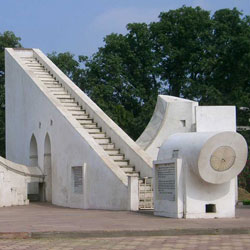
Ujjain is known to be a Greenwich of India due to the fact that the first meridian of longitude passes through it. Located on site of India’s first scientific observatory, Vedha Shala is one of the most tourist visited places. So, whenever you plan a trip to Ujjain, do visit Vedha Shala. History: As far as the history of Vedha Shala is concerned, it was built by Maharaja Jai Singh between 1725 and 1730. There is no denying the fact that Vedha Shala is considered to be a masterpiece and an excellent work of art. Even today, Jantar Mnatar is a significant place for all the historical as well as astronomical research. It is also to be noted here that Ujjain since old times has been a research place for Hindu astrologers and scholars. When Vedha Shala in Ujjain was erected, it attained the biggest milestone in the 18th century. Architecture Vedha Shala is one of the greatest paragons of brainpower, which was built in Ujjain, which is known to be the 'Greenwich of India'. It was Savai Raja Jai Singh, who manoeuvred the world of terrestrial and spiritual science with the erection of this yantra. Vedha Shala has some prominent monuments within it namely, Shanku Yantra, Nadivalaya Yantra, Samrat Yantra and Digyansha Yantra. Visitor Information: The timings to visit Vedha Shala are from 7:00 AM to 7:00 PM from Monday to Sunday. The time required to visit Vedha Shala is for over 1-2 hours. The entry fees for Vedha Shala is INR 40 per head (above 15 years of age) for Indian citizens, INR 200 per head for foreign citizens, INR 50 for camera and INR 150 for audio guide. Once you visit this place, you will surely enjoy the amazement. Best Time to Visit: The best time to visit Ujjain is in winters or spring season that is from October till March. It is recommended not to visit Ujjain in summers. The reason why winters are best is because during these months, the temperature stays between 3 degrees Celsius (Nights of January) and 20 degrees Celsius. How to Reach: For those who are travelling via air, the nearest airport to Ujjain is Indore. There are daily flights from Indore to Mumbai, Kolkata, Delhi, Bhopal and Ahmadabad. For those who are travelling by train, there are three major railway stations out there namely, Ujjain City Junction, Vikram Nagar and Chintaman (metre gauge). For the road travellers, Ujjain is well-connected by road and those which connect it to other major cities are Agar Road, Indore Road, Dewas Road, Maksi Road and Badnagar Road. A huge number of busses also ply on these roads and the widely known Ujjain bus stands are Dewas Gate and NanaKheda. Nearby Attractions: Below are a few places mentioned where one must visit as and when they go to Ujjain for their outing: • Mahakaleshwar • Bade Ganesh ji ka Mandir • Ram Ghat • Gopal Mandir, Ujjain • Kaliadeh Palalce, Ujjain • Kal Bhairava, Ujjain • Vedh Shala Ujjain • Chintamani Ganesh Ujjain • Harisiddhi Temple Ujjain • Bhartrihri Caves
Explore More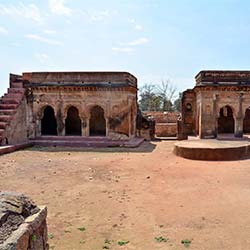
About The Dauji Ki Haveli The Dauji Ki Haveli is a historical mansion located in Orchha, a town in the Indian state of Madhya Pradesh. This haveli is known for its stunning architecture and intricate design, making it a popular tourist attraction in the region. Timings Of Dauji Ki Haveli The Dauji Ki Haveli is open to visitors from 9:00 AM to 5:00 PM on all days of the week. Entry Fee The entry fee for Dauji Ki Haveli is INR 20 for Indian nationals and INR 250 for foreign tourists. Required Time And Restricted Items It is recommended to spend at least 1-2 hours exploring the Dauji Ki Haveli. Visitors are not allowed to carry food, beverages, or photography equipment inside the haveli. Architecture Of Dauji Ki Haveli The architecture of Dauji Ki Haveli showcases a blend of Rajput and Mughal styles. The haveli features beautifully carved stone pillars, intricate frescoes, and ornate jharokhas. Best Time To Visit The best time to visit Dauji Ki Haveli is during the winter months from October to March when the weather is pleasant and ideal for sightseeing. How To Reach Orchha is well-connected by road, rail, and air. The nearest airport is in Gwalior, approximately 120 kilometers away. Jhansi is the nearest railway station, located about 16 kilometers from Orchha. Visitors can also reach Orchha by road via well-maintained highways. History Of Dauji Ki Haveli The Dauji Ki Haveli was built during the 17th century by the Bundela rulers of Orchha. It served as a residence for the royal family and later became a heritage site preserving the rich cultural heritage of the region. Inside Dauji Ki Haveli Inside the Dauji Ki Haveli, visitors can admire the intricate wall paintings depicting mythological tales, ornate mirror work, and beautiful lattice windows. The haveli also houses a collection of antique furniture and artifacts. Traveling Tips It is advisable to wear comfortable footwear while visiting the Dauji Ki Haveli as there may be uneven surfaces and stairs to navigate. Additionally, carrying a bottle of water and sunscreen is recommended, especially during the summer months. Hotels Near Dauji Ki Haveli There are several hotels and guesthouses near Dauji Ki Haveli that offer comfortable accommodation options for tourists. Some of the popular hotels include Hotel Sheesh Mahal, Orchha Palace and Convention Centre, and Amar Mahal. Nearby Tourist Spots While visiting Dauji Ki Haveli, tourists can also explore other nearby attractions in Orchha such as the Orchha Fort, Chaturbhuj Temple, Ram Raja Temple, and Betwa River. These sites offer a glimpse into the rich history and culture of the region.
Explore More
About The Sunder Mahal The Sunder Mahal is a beautiful palace located in Orchha, a historic town in the state of Madhya Pradesh, India. It is a significant historical monument that reflects the rich cultural heritage of the region. Built in the 16th century, the Sunder Mahal is a fine example of Mughal architecture and is dedicated to the memory of the famous saint, Syed Mohammad Hadi. Timings Of Sunder Mahal The Sunder Mahal is open to visitors from 9:00 AM to 5:00 PM every day of the week. Entry Fee The entry fee to visit the Sunder Mahal is minimal, making it accessible to all visitors. Required Time And Restricted Items It is recommended to spend at least an hour exploring the Sunder Mahal and its surroundings. Visitors are advised not to carry any prohibited items inside the monument. Architecture Of Sunder Mahal The Sunder Mahal exhibits a unique blend of Mughal and Rajput architectural styles. The palace features intricate carvings, beautiful domes, and delicate marble work that leave visitors in awe of its grandeur. Best Time To Visit The best time to visit the Sunder Mahal is during the winter months, from October to March, when the weather is pleasant and ideal for sightseeing. How To Reach Orchha is well-connected by road and rail. The nearest airport is in Gwalior, which is approximately 120 kilometers away from Orchha. Visitors can hire taxis or take public transport to reach the Sunder Mahal. History Of Sunder Mahal The Sunder Mahal was constructed by the Bundela ruler, Maharaja Bir Singh Deo, in memory of his spiritual guru, Syed Mohammad Hadi. The palace served as a place of worship and pilgrimage for followers of the saint. Inside Sunder Mahal Inside the Sunder Mahal, visitors can explore the beautifully decorated chambers, intricate wall paintings, and the serene prayer hall dedicated to Syed Mohammad Hadi. The palace provides a peaceful and spiritual ambiance that transports visitors back in time. Traveling Tips Visitors are advised to wear comfortable clothing and footwear while exploring the Sunder Mahal, as there are several stairs and pathways to navigate. It is also recommended to carry water and sunscreen, especially during the hot summer months. Hotels Near Sunder Mahal There are several hotels and guesthouses near the Sunder Mahal that offer comfortable accommodation options for visitors. Some of the popular hotels in Orchha include Amar Mahal, Orchha Palace, and Bundelkhand Riverside. Nearby Tourist Spots Of Sunder Mahal While visiting the Sunder Mahal, tourists can also explore other attractions in Orchha, such as the Orchha Fort, Chaturbhuj Temple, and Raja Mahal. The town of Orchha is known for its rich history, stunning architecture, and tranquil surroundings that make it a must-visit destination for history and culture enthusiasts.
Explore More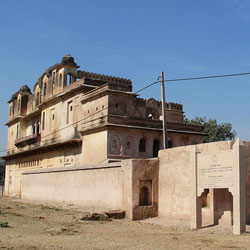
Orchha is a lovely town of the state Madhya Pradesh. This small town is pretty popular for its exquisite and attentive archaeological memorials and the Rai Praveen Mahal is one best among them. The word 'Orchha' means hidden place. This is literally for the location of the town. It is luxuriantly covered with serene flora and beautiful nature. Maharaja Rudra Pratap Singh founded Orchha in 1501 on the banks of Betwa River. This is one of the reasons behind the serene beauty of this town. Visitor Information: Solo visitors, especially women are not advised to enter the palace structure without other tourists or government authorized guards are there. It is just for your safety! Traveler Tips: Rai Praveen played a crucial role in the history of this place. If you want to know more about her watch the light and sound show organized in Orchha every year. History: You must be thinking who Rai Parveen was! Various historical sources state that she was a strong, multi-talented and one of the most beautiful women of her era. She was a dancer, singer and efficient poetess. If you visit Rai Parveen Mahal, Orchha today, you can see a few of her belongings are still kept there. She was the beloved courtesan of Raja Indramani. Her enchanting beauty and powerful poetic skills soon started becoming famous and crossed the boundaries of Mughal Samrat Akbar's palace. He got smitten by her charm and summoned her to be present at his court. Raja Indramani was frightened by Akbar's power and thus could not defy his proposal. Rai Praveen came to Akbar darbar and there she recited a couplet – 'Vinit Rai Praveen ki, suniye sah sujan. Juthi patar bhakat hain, bari, bayas, swan.' The meaning of these lines is as follows – 'O' good and intelligent, please listen to the prayer of Rai Praveen. Only a lower caste individual, barber and scavengers eat from a plate partaken by someone else.' Akbar was intelligent enough to understand the inner meaning of her couplet but at the same time he was impressed also with her bravery and intelligence, so he rewarded her and sent her back to Orchha with full dignity. Architecture: Raja Indramani constructed the structure and the courtyard of the Rai Praveen palace in 1618. It shows a reflection of the Mughal architecture. It is surrounded by a lush green garden. The double-storied structure of the palace is decorated with superbly engraved paintings of Rai Praveen in which she can be observed in different dance poses and other special moods. The building was constructed in such a perfect manner that all its halls and chambers are filled with appropriate light and air all through the day thus offers a soothing experience for the residents. Today, the garden area of the palace consists of weed and dry shrubs. But the interior of the palace walls still maintains the true sense of the wall linings as those were before ages. As the historic lady was a popular and skilled dancer of her era, the palace includes various dance halls that were used for organizing her dance shows. Also, there are many underground apartments, a few lawns and some small-sized temples inside the palace premises. The garden of the Rai Praveen palace is called as Anand Mahal Bag. Best Time to Visit: The best time to visit this Orchha palace is either during January – April or September – December. You can enter the palace for sightseeing between 9 AM and 5 PM. How to Reach? It is quite easy to reach Orchha from Delhi. The visitors from Delhi or NCR often plan to combine their visit to the Taj Mahal and Khajuraho temples with the Rai Praveen Mahal, Orchha. The nearby railway station of the palace is Jhansi. You can also board a flight to reach Orchha by airways. The nearby airport is Gwalior. So, plan your visit accordingly. Have a happy journey!
Explore More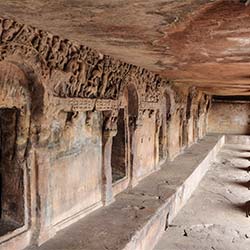
Featuring some of the oldest images of Hinduism and Jainism along with a number of ancient caves temples, Udaygiri Caves Sanchi, is one of the most visited tourist attractions in the heart of India i.e., Madhya Pradesh. The name of the caves, Udaygiri, is literally translated into ‘mountain of the rising’ and comprises of a U-shaped plateau. These caves exhibit an exquisite picture of the local art form during the 4th – 5th centuries. These caves are located around 4kms away from the Vidisha town and consist of a series of at least 20 caves. Carved out of the rocks atop the Udaygiri hill, these caves are certainly a delight for all the history buffs. It Is Known For:-1) The brilliant depiction of Hindu and Jain scriptures and deity images craved out intricately in the caves.2) The flavor of Buddhist monuments that is reflected within the caves.3) The archeological evidence of the Gupta era that is mirrored in the carving on the walls of the caves.4) The twenty or more caves that have inscriptions and scriptures from the ancient times.Best Time To Visit:-The best time to visit the Udaygiri hills is between the months of October and March. Madhya Pradesh, being in the heart of the country, can get pretty hot during the summer days. The humidity in the air can also increase and you may not be able to enjoy the visit to the caves in hot summers. Therefore, it is advisable to visit the caves during the cool months to make the best of the visit. Reaching There:-Udaygiri caves are located around 4kms from the town of Vidisha, which is 13kms away from the famous tourist spot Sanchi. The Udaygiri caves are easily accessible via roadways. Even the climb up the Udaygiri hills is connected by road which makes it easy for anyone to reach these caves. Nearest Railway Station:- Vidisha Railway StationNearest Airport:- Raja Bhoj Airport in Bhopal
Explore More5N Ujjain - Maheshwar - Mandu - Indore Tour
6 Days/ 5 Night
Dhar - Indore - Ujjain - Omkareshwara - Khargone
3N Indore - Ujjain - Omkareshwer Tour
4 Days/ 3 Night
Indore - Ujjain - Omkareshwara
6D Gwalior - Khajuraho - Orchha Tour
6 Days/ 5 Night
Jhansi - Gwalior - Khajuraho - Orchha - Datia - Morena
2D Pachmarhi Deluxe Trip Package 2 Guest
2 Days/ 1 Night
Pachmarhi
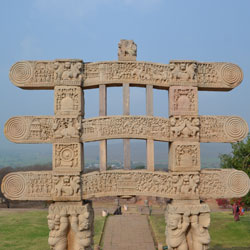
Four Gate Ways of Sanchi are the gates that are known as Toranas which surround the Great Stupa. The gates are named as northern, southern, eastern and western. Every gate has its own meaning and significance. Architecture: As we have informed in the aforementioned paragraph, there are four gates and each one of them has its own significance. The Northern Gateway is crowned by a wheel of law and displays all the marvels related to Buddha. On the other hand, the Southern Gateway has statues that depict the birth of Gautama Buddha. The Eastern Gateway, which was erected in 35 BC, is one of the four gateways located in Sanchi, which showcases the different incidents of Gautama Buddha’s life. Tis gate also displays the time when Gautama left his palace for enlightenment. In addition to this, it also displays the dream of Maya, Gautama’s mother before he was born. Moreover, there are four elephants, which offer support to the architraves of the gate. The Western Gateway demonstrates the seven embodiments of Lord Buddha. Once you visit Four Gate Ways Of Sanchi, you would definitely enjoy the incarnations and the projection. The place scores full marks on all counts, be it creativity, architecture, cleanliness and what not. Best Time to Visit: Best time to visit Four Gateways of Sanchi is during the months from November to February. Visitor Information: For those who are wondering about the entry fees of Four Gate Ways of Sanchi then let us tell you, there is no entry fee. Moreover, it would take you for over 30 minutes for the sightseeing of this place. Moreover, if you plan to purchase anything, it is advised to cross check the prices with the locals and only then go for it. Traveller Tips: One of the most suggested travelling tips for everyone is that one should carry their own high quality camera and plenty of water. How to Reach: Sanchi is a place that is well-connected by all means of transportation. For those who are travelling by bus, there are deluxe A/C buses that are available from many big cities of India to Sanchi. For those who are traveling via rail, the nearest railway station to Sanchi is also Bhopal, which helps in easily accessibility to Sanchi. Moreover, there are tourist taxi services also available from Bhopal to Sanchi that would charge you for upto INR 1000. Sanchi doesn’t have its own airport, so if you are planning to reach there by air, then Raja Bhoj is the airport in Bhopal that happens to be the nearest one for about 67 kms. In addition to this, the taxi fare is about INR 1,000 from Bhopal airport to Sanchi. Nearby Attractions: Belo are a few nearby places to Four Gate Ways of Sanchi that one must add on their list of places to visit. Scroll down and have a look: Sanchi Stupa The Great Bowl Ashoka Pillar Sanchi Museum Buddhist Vihara Gupta Temple
Explore More
Baghel Museum is a rich repertoire of varied possessions of all the Maharajas of the Baghel dynasty. The museum is the place that showcases artifacts which are direct proofs of the luxurious and affluent lifestyle of the great rulers and kings of the Baghel dynasty. It is not like all the museums that I even have seen thus far. Right from their clothes to their stationary to their cutlery to their arms and ammunition, everything that you can accompany a ruler was present within the museum. It used to be especially intrigued by the arms gallery of the museum which showcased all types of swords, guns, shields and other important weapons that were utilized in the fights in those eras. Baghel Museum also possesses tons of pricy silver and gold artifacts also. The guide told us tons of it has been looted. That’s the rationale why there are strict rules against photography and videography inside the museum. The museum also features a unique collection of antiques, glass items, paintings, and other rare articles. The foremost fascinating part of the museum was the stuffed body of the primary white tiger spotted in Rewa by the Maharaja of Rewa, Martand Singh. The guide told us that in those days hunting was considered honorable. Often the king won’t choose hunting to urge out of boredom. We cracked jokes around how we have social media and few friends to combat boredom and zip like their royal ways. The history behind the Bandhavgarh Bandhavgarh has been flourished through various significant historical legends most of which are learned from the legends of Ramayana. Interestingly, Bandhavgarh may be a legendary place that has much historical importance. One can learn through the traditional books of the Narad Panch Ratra and therefore the Shiv Purana that this place is being related to Ramayana. The word Bandhavgarh may be a combination of two words: Bandhav+ Garh where Bandhav means brother and Garh means Fort. Therefore the meaning of Bandhavgarh is brother’s fort. The name Bandhavgarh given to the reserve is thanks to the presence of an ancient fort within the hillock of the Vindhya ranges of Umaria. It is been believed that Lord Rama gifted this amazing fort to his younger brother Lakshmana. The Bandhavgarh fort also has scriptures with many convincing shreds of evidence of architectural techniques and human culture and also interestingly, the legend explains that the ruined fort was being reconstructed by two monkeys who built a bridge between Lanka and therefore the mainland. The fort also allows you to explore several artificial caves with inscriptions and rock paintings. Mahansar Bandhavgarh is also a great place. It is an old village which is famous for its fort and liquor. The Sona ki Dukan and the Sahaj Ram Poddar Chetri is the best places here. Nearby Attractions of Baghel Museum There are several attractions in which one can enjoy their visit to Baghel Museum Bandhavgarh. Some are Bandhavgarh fort, Tala village, Bandhavgarh hill, etc. There are not any records mentioning the historical dates of the development of the Bandhavgarh Fort. It's assumed that the fort must be 2,000 years old. the rationale behind this is often that the Narad-Panch Ratra and therefore the Shiva Purana, talk about this fort. to not mention that these are ancient relics quite 2000 years old. Bandhavgarh Hill is the highest hill within the reserve of Bandhavgarh lying in an altitude of 807 m above the ocean level. This range of hills is made from sandstone and water that permeates into it. As a result of this quirky formation, there are many streams and springs that formed and originated from this hill. Culture and Tradition No other state in India, but Madhya Pradesh, enmeshes numerous different flavors of tradition and culture. It is home to people professing all the main religions of India, who dwell in perfect harmony and amity. Aside from them, numerous colorful tribes add on to the colorful cultural collage of the state. The culture of Madhya Pradesh may be a harmonious amalgamation of Hindus, Muslims, Buddhists, Jains, Christians, and Sikhs. Moreover, the tribal communities of the state comprise of various tribes like Bhils, Gonads, Oraons, Kols, Bhilalas, Murias and Korkens, to call a couple of. The people here belong to numerous different ethnic backgrounds and religion and reflect the concept of Indian secularism and contribute to the animated cultural effervescence of the state. These were some beautiful cultures and traditions that we find in Madhya Pradesh and Around Baghel Museum. Best Time to Visit Bandhavgarh National Park has the Baghel Museum as a part of it and it is open for visitors from the 15th of October to the 30th of June. Snuggled within the heart of India, Madhya Pradesh, the height season for visiting this wildlife retreat is that the pleasant weather of winters. The height months to go to are from October to March. The best time to go to Bandhavgarh Park and Baghel Museum varies with the aim with which tourists mean to visit the sanctuary. If curious about viewing bird species along with the artifacts in the museum then months from October to January is that the most suited time. Watch the feathery species in the green surrounding of the forest, most of them migrating during this season. Months of early summer, April, May, and June are considered the simplest time to try wildlife photography and tiger photography. During this point, expect unusual photography of tigers as heat causes animals to stay on the brink of the water source. Avoid the height summer because the heat gets unbearable for safaris. How to reach? This place is well connected to the major cities of the country. Those who are planning to visit the museum can make it to the place by traveling from flight, railways or other transportation ways. Whatever you avail you will reach the place comfortably. The place is open from 10 am to 3 pm and from 5 pm to 8 pm.
Explore More
About The Dhar Fort The Dhar Fort, also known as Dhar Palace, is a historical fort located in the town of Dhar in Madhya Pradesh, India. It was built by the Parmar rulers in the late 18th century and served as the residence of the rulers of Dhar. The fort is an architectural masterpiece and reflects the rich cultural heritage of the region. Timings Of Dhar Fort The Dhar Fort is open to visitors from 10:00 AM to 6:00 PM on all days of the week. Entry Fee The entry fee for the Dhar Fort is INR 20 for Indian tourists and INR 250 for foreign tourists. Required Time And Restricted Items It is recommended to spend at least 1-2 hours exploring the Dhar Fort. Visitors are not allowed to carry weapons, inflammable items, or alcohol inside the fort premises. Architecture Of Dhar Fort The Dhar Fort showcases a blend of Rajput and Mughal architectural styles. The fort is made of red sandstone and features intricately carved pillars, domes, and arches. The walls of the fort are adorned with beautiful paintings and sculptures. Best Time To Visit The best time to visit the Dhar Fort is during the winter months from October to March when the weather is pleasant and suitable for exploring the historical site. How To Reach The Dhar Fort is easily accessible by road. The nearest railway station is Dhar Junction, which is about 2 kilometers away from the fort. Indore Airport is the closest airport, located approximately 56 kilometers from Dhar. History Of Dhar Fort The Dhar Fort was built by Raja Bhoj in the late 18th century and later served as the residence of the Parmar rulers of Dhar. The fort has witnessed many historical events and played a significant role in the region's history. Inside Dhar Fort Inside the Dhar Fort, visitors can explore the various structures including the palaces, temples, and gardens. The fort also houses a museum that displays artifacts, weapons, and paintings from the bygone era. Traveling Tips It is advisable to wear comfortable footwear as there is a fair amount of walking involved in exploring the Dhar Fort. Carry a water bottle and sunscreen to stay hydrated and protected from the sun. Hotels Near Dhar Fort There are several hotels near the Dhar Fort where visitors can stay during their visit. Some of the popular hotels include Hotel Sheetal Palace, Hotel Trishul, and Hotel Aanchal. Nearby Tourist Spots Of Dhar Fort There are several tourist attractions near the Dhar Fort that visitors can explore, including the Bhoj Shala, Bagh Caves, and Mandu Fort. These sites offer a glimpse into the rich history and culture of the region.
Explore More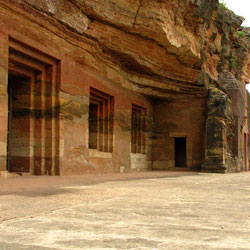
About The Bagh Caves The Bagh Caves, located in the Dhar district of Madhya Pradesh, are a group of nine rock-cut caves that date back to the 5th-7th century AD. These caves are renowned for their exquisite Buddhist murals and carvings, which provide a glimpse into the rich cultural heritage of ancient India. Timings Of Bagh Caves The Bagh Caves are open to visitors from 9:00 am to 5:00 pm on all days of the week. Entry Fee The entry fee for Indian visitors is Rs. 15 per person, while foreign tourists are charged Rs. 200 per person. Additionally, there is a nominal fee for carrying cameras inside the caves. Required Time And Restricted Items It is recommended to allocate at least 2-3 hours to explore the Bagh Caves thoroughly. Visitors are not allowed to carry food, beverages, or pets inside the caves. Smoking and littering are strictly prohibited. Architecture Of Bagh Caves The architecture of the Bagh Caves reflects a blend of Indian rock-cut architecture and Buddhist art. The caves feature intricately carved pillars, doorways, and sculptures that showcase the craftsmanship of the ancient artisans. Best Time To Visit The best time to visit the Bagh Caves is during the winter months, from October to March, when the weather is pleasant and ideal for exploring the caves. How To Reach The Bagh Caves are easily accessible by road from Dhar, which is well-connected to major cities like Indore and Bhopal. Visitors can also hire a taxi or take a bus to reach the caves from nearby towns. History Of Bagh Caves The Bagh Caves were excavated during the ancient Gupta period, between the 5th and 7th centuries AD. These caves served as monastic retreats for Buddhist monks and were adorned with elaborate paintings depicting scenes from the life of Buddha. Inside Bagh Caves Inside the Bagh Caves, visitors can admire the stunning murals that adorn the walls and ceilings of the caves. These paintings depict various Buddhist motifs, divine figures, and mythical creatures, offering a fascinating insight into ancient Indian art and culture. Traveling Tips It is advisable to wear comfortable clothing and footwear while exploring the Bagh Caves, as there is some walking involved. Additionally, carrying a bottle of water, sunscreen, and a camera is recommended to make the most of your visit. Hotels Near Bagh Caves Some of the hotels near the Bagh Caves include: 1. Hotel Shreenath Palace 2. Hotel Meera Palace 3. Hotel Anjushree Nearby Tourist Spots Of Bagh Caves While visiting the Bagh Caves, tourists can also explore other nearby attractions such as the Dhar Fort, Bhoj Shala, and the Mandu Fort, which are steeped in history and offer a glimpse into the rich cultural heritage of Madhya Pradesh.
Explore More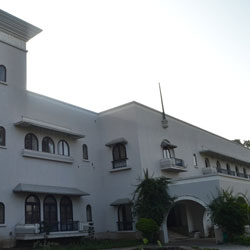
About The Jhira Bagh Palace Located in the city of Dhar in the state of Madhya Pradesh, the Jhira Bagh Palace is a magnificent heritage property that offers a glimpse into the grandeur and opulence of the past. Originally built as a hunting lodge by the Maratha rulers of Dhar, the palace has now been converted into a luxurious hotel that offers guests a unique experience of living like royalty. Timings of Jhira Bagh Palace The Jhira Bagh Palace is open to visitors from 9:00 AM to 6:00 PM on all days of the week. Entry Fee The entry fee for visiting the Jhira Bagh Palace is INR 100 per person for Indian nationals and INR 300 per person for foreign tourists. Required Time and Restricted Items Visitors usually spend around 2-3 hours exploring the palace and its surroundings. It is advisable to carry a valid ID proof for entry. Smoking, alcoholic beverages, and pets are not allowed inside the palace premises. Architecture of Jhira Bagh Palace The architecture of the Jhira Bagh Palace is a beautiful blend of Maratha and Mughal styles, featuring intricate carvings, stunning archways, and majestic domes. The palace is surrounded by lush gardens, serene lakes, and cascading waterfalls, creating a picturesque setting that transports visitors to a bygone era. Best Time to Visit The best time to visit the Jhira Bagh Palace is during the winter months from October to March when the weather is pleasant and ideal for exploring the palace and its surroundings. How to Reach The Jhira Bagh Palace is located in Dhar, which is well-connected by road to major cities like Indore and Bhopal. The nearest airport is Devi Ahilya Bai Holkar Airport in Indore, approximately 60 kilometers away. The nearest railway station is Dhar Railway Station, which is well-connected to major cities in the region. History of Jhira Bagh Palace The Jhira Bagh Palace was built in the 18th century by the Maratha rulers of Dhar as a hunting lodge. Over the years, the palace has been renovated and restored to its former glory, showcasing the rich cultural heritage of the region. Inside Jhira Bagh Palace Inside the Jhira Bagh Palace, visitors can explore the beautiful courtyards, ornate halls, and intricately designed rooms that once served as the residence of the royal family. The palace also houses a museum that displays artifacts, paintings, and sculptures from the Maratha era. Traveling Tips - Wear comfortable footwear as the palace grounds can be extensive to explore. - Carry a water bottle and sunscreen to stay hydrated and protected from the sun. - Respect the heritage property by refraining from littering or causing any damage to the structures. Hotels Near Jhira Bagh Palace with Names 1. The Renest River Country Resort 2. The Grand Bhagwati Palace 3. Hotel Shri Radhe Krishna Palace Nearby Tourist Spots of Jhira Bagh Palace 1. Mandu Fort: A historical fort known for its architectural marvels 2. Dhar Fort: A majestic fort offering panoramic views of the city 3. Bhoj Shala: An ancient educational institution with intricate carvings
Explore More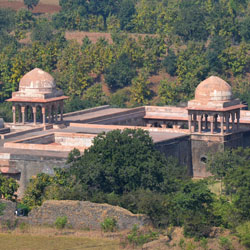
The palace of Baz Bahadur now belongs to the Hill Fort complex, Mandu. On your trip to Mandu, you will surely not want to miss an opportunity of visiting the charm of this palace. The entire city of Mandu is filled with constructions which are having Islamic architectural style. This is because Muslim rulers have dominated the place for many decades. Visitor Information: Entry to the Baz Bahadur’s Palace is not free for the tourists. The charges are as below - • Indian tourists – 5 Rs • Foreigner tourists – 100 Rs • Video camera – 25 Rs Traveler Tips: Though the palace is open from 7 AM to 7 PM, you can best enjoy visiting the palace is from sunrise to sunset. Daytime is preferable for visiting as there is no special lighting facility available for the dusk. So, plan your visit accordingly. History: You must be thinking who was Baz Bahadur? He was the sultan of this city from 1555 to 1561. It was during his reign, Mandu reached its highest grandeur. But he has built the palace much before he became a king i.e. in 1509. This beautiful edifice was built on the hill and beneath lies the Rewa Kund, which is used as a water supply source. Architecture: The Baz Bahadur's Palace, Mandu shows a great example of ancient rock architecture of the 5th – 6th centuries. The overall architecture of this monument reflects Islamic as well as Rajput style. The entrance of the monument has 40 big stair steps to climb but having landings at intervals. A passage is there on both sides of the royal gateway, which has lined up guard quarters. Then comes the main entrance to the palace. Visitors may see a range of hallways, courtrooms, etc. while entering through it. A gorgeous cistern is there at the center of the entrance. Apart from this huge hall, you can spot a platform having octagonally shaped there. It was used then to enjoy the view of the outside lush green garden. On the terrace of the palace, you can find a baradari or recreation area. This place was used to get a magnificent view of the surrounding of the palace. Best Time to Visit: Mandu is pleasant visiting from November to February. You can visit the palace anytime a day between 7 AM to 7 PM. But the most recommended time to visit is during sunlight i.e. 8 AM to 5 PM. You will be required at least half an hour to enjoy the entire architecture. How to Reach? By road – Mandu, Madhya Pradesh is counted among one of the desired destinations for most of the tour of India, hence it has a good road network. Manu is reachable from most of the major cities and towns in the country. Regular bus service is available between mandu and Indore and Mandu and Bhopal. By air – The nearest airport is Indore airport which is 100 km away from Mandu. By train – Railways are also a good travel option for being here. You need to reach Ratlam. Otherwise, you can also ride through the branch root of the Indore railway; it is 99 km away from Mandu. Nearby Attractions: When you are at Mandu, you can also enjoy visiting – • Jahaz Mahal • Rani Roopmati’s Pavilion • Jama Masjid • Hindola Mahal • Champa Baoli and Hammam Some popular restaurants nearby include – • Ganga Jamuna Restaurant • Indore Dhaba • Badhri Dhaba • Shivani Restaurant • Baba Ka Dhaba, etc.
Explore More